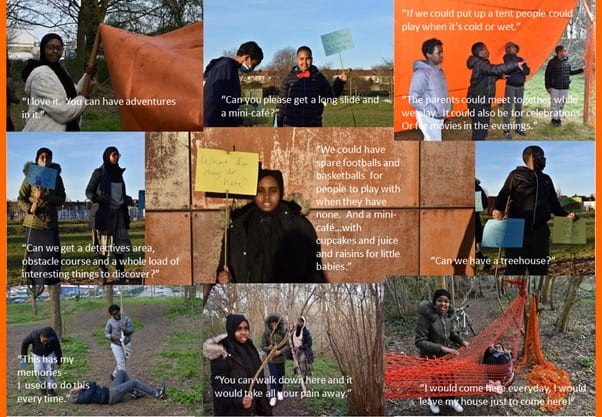Find Your Village: involving children and young people from ethnically diverse backgrounds in improvements to local neighbourhood geography
How can local policies about neighbourhood geography could take more account of the experiences of young people from ethnically diverse communities?

Previous work has drawn connections between the professional experience of health visitors, early years educators, developmental therapists and doctors, the systematic review of quantitative and qualitative literature, the experiential and interactional world of migrant families in a British inner city, and the ways in which ‘place’ can shape activity and opportunity. Children whose parents have had experience of forced or challenging migration are referred to our child development and disability service with a range of developmental difficulties – language and learning difficulties, and questions about possible autism – substantially more frequently than their white British peers – for example Somali pre-school children are six times more likely to be referred for possible autism. Having heard stories about how, in a Somali (or African) village, and we suspect in many other parts of the world, the whole community provides a structure within which children grow up happily and safely, and stories of fear, uncertainty and isolation of living in tower blocks in a British city has clarified this challenge as one with multiple layers, but most centrally about the cultural clash of moving from a communal to an individualistic society, with multiple sources of stress, and impoverished, frightening environments with key messages for policy-makers extracted.
From these starting points, the project undertook a journey of exploring and looking to improve children’s early opportunities for play and interaction, and to improve the wellbeing and sense of community and connectedness for their families, this was called the ‘Find your Village’ project.
What did the project involve?
This project sought to build on the previous work of the ‘Find your Village’ project and develop young peoples’ ability, creatively, to contribute to evidence-building and policy development about neighbourhood geography and ‘place-making’ as a prototype/template for including the experiences of children and young people from ethnically diverse communities prototype/template as young place consultants with wellbeing and community at the heart. The aim was to explore how local policies about neighbourhood geography could take more account of the experiences of young people from ethnically diverse communities.
The project included the following activities:
- Identify secondary school participants (two groups of 4 from year-group bubbles to permit outdoor activities).
- Workshops for secondary school/teenage participants – mix of zoom and outdoors – that sought to bring them together, gather their ideas, imagine change, explore ways to portray and/or enact the change (for example using bodies to make the shapes of things they would like to be there), creating images/video/audio that can be presented to stakeholders.
- Creative project to consider options, design and build an indicative example of an outdoor temporary structure for children and families to meet and to play outdoors regardless of viruses or weather.
- Consultancy involvement from Mora McLagan, Filmmaker in a workshop to support the young people to make their own short films using free (Adobe Spark) software.
- Explore key local and national policy frameworks and relationships within which these advocacy activities might contribute.
Who are the team and what do they bring?
- Tom Allport (Bristol Medical School) is a researcher and paediatrician who works on understanding ways to improve children and young people’s development and participation despite the challenges of disabling situations.
- Mora McLagan (Atgo Productions) is a Communications Consultant and former journalist now working in the charity sector. Having previously studied Social Anthropology and practiced participatory research, she is interested using digital story-telling to empower individuals to improve their communities and transform lives around them.
What were the results?

Photography and Quotes from a Young People’s Consultation on Netham Park
- Images, video and audio to communicate creative ideas and messages.
- Ideas for how social housing estate might contribute more positively to young people’s and families’ wellbeing, play and connectedness.
- Engagement with current and future design and building processes of local urban developments.
- Interface with ‘indicative’ Council award of CIL funding to Netham Park to improve facilities for children, young people and families.
- Evaluation, risk-assessment and dissemination of concept of temporary structures for children and families to meet and to play outdoors.
- Report and further policy briefing.
The project was able to attain additional NIHR RCF funding and ‘Green’ Social Prescribing Funding to further develop the project. Tom Allport was also invited to be on the steering group for Bristol City’s new Parks and Green Spaces Strategy development process.

